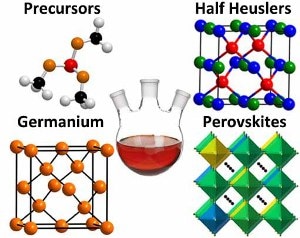Jun 16 2017
According to Javier Vela, Researcher at the U.S. Department of Energy’s Ames Laboratory, improvements in TV displays, computer processors and solar cells will come from scientific progress in the synthesis of low-dimensional nanomaterials.
 Some of the inorganic semiconductors under study by Vela and co-workers. (Credit: U.S. Department of Energy’s Ames Laboratory)
Some of the inorganic semiconductors under study by Vela and co-workers. (Credit: U.S. Department of Energy’s Ames Laboratory)
Ames Laboratory Researchers are renowned for their expertise in the synthesis and manufacturing of materials of varied types, as stated by Javier Vela, who is also an Iowa State University Associate Professor of Chemistry. In numerous instances, those new materials are manufactured in bulk form, which means micrometers to centimeters in size. Vela’s team are working with miniature, nanometer or one billionth of a meter-sized, nanocrystal.
We’re trying to find out what happens with materials when we go to lower particle sizes, will the materials be enhanced or negatively impacted, or will we find properties that weren’t expected. Our goal is to broaden the science of low-dimensional nanomaterials.
Javier Vela, Researcher, U.S Department of Energy Ames Laboratory and Associate Professor of Chemistry, Iowa State University
In an invited paper published in Chemistry of Materials entitled, “Synthetic Development of Low Dimensional Materials”, Vela and Co-Authors Long Men, Miles White, Himashi Andaraarachchi, and Bryan Rosales focused on the highlights of some of their latest work on the synthesis of low dimensional materials.
One of those topics was advancements in the synthesis of germanium-based core-shell nanocrystals. Vela says the industry is very keen about semiconducting nanocrystal-based technologies for applications such as solar cells.
Small particle size can impact a number of things from transport properties (how well a nanocrystal conducts electricity and heat) to optical properties (how strong it interacts with light, absorbs light and emits light). This is particularly true in photovoltaic solar cells.
Let’s say you’re using a semiconductor material to make a solar device, there’s often different performance when solar cells are made from bulk materials as opposed to when they are made with nanomaterials. Nanomaterials interact with light differently; they absorb it better. That’s one way you can manipulate devices and fine tune their performance or power conversion efficiency.
Javier Vela, Researcher, U.S Department of Energy Ames Laboratory and Associate Professor of Chemistry, Iowa State University
Outside of solar cells, Vela says there is great interest in using nanocrystals in computer displays and quantum dot television, biological imaging, optical devices like LEDs and telecommunications.
He says there are numerous challenges in this area because based upon the quality of the nanocrystals used, one can see diverse emission properties, which can influence the purity of light.
“Ultimately the size of the nanocrystals being used can make a huge difference in the cleanliness or crispness of colors in TV and computer displays,” said Vela. “Television and computer technology is a multibillion dollar business worldwide, so you can see the potential value our understanding of properties of nanocrystals could bring to these technologies.”
In the paper, Vela’s team also described advancements achieved in the study of synthesis and spectroscopic characterization of organolead halide perovskites, which Vela says are some of the highly promising semiconductors for solar cells because of their easier processability and low cost. He adds photovoltaics made of these materials presently reach power conversion efficiencies of more than 22 %.
Vela’s research in this area has looked closely at mixed-halide perovskites. He says his team has discovered these materials display fascinating photo physical and chemical properties that people had not noticed before, and presently they are aiming to better understand the correlation between the structure and chemical composition of perovskites and how they act in solar cells. “One of our goals is to use what we’ve learned to help lower the cost of solar cells and produce them more reliably and readily,” Vela said.
Furthermore, Vela’s team is examining how to replace lead in traditional organolead halide perovskites with something less lethal, like germanium.
In principle, this is an area that should be much better known, but it’s not. When we’ve been able to substitute germanium for lead, we have been able to produce a lighter perovskite, which he says could positively impact the automotive industry, for example. This could have great implications for transportation applications where you don’t want a lot of lead because it’s so heavy.
Javier Vela, Researcher, U.S Department of Energy Ames Laboratory and Associate Professor of Chemistry, Iowa State University
In the days to come, Vela says his team’s focus will be on the progress of science in low-dimensional materials.
“We’re not working with well-known materials, but the newest; the most recently discovered,” Vela said. “And every time we can advance the science we’re one step closer to opportunities for more commercialization, more production, more manufacturing and more jobs in the U.S.”
This research was supported by the U.S. Department of Energy’s Office of Science.